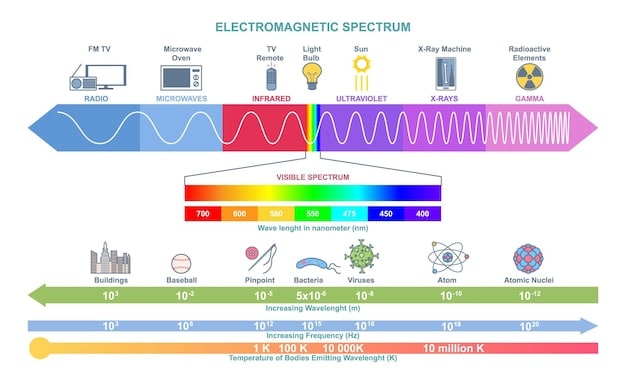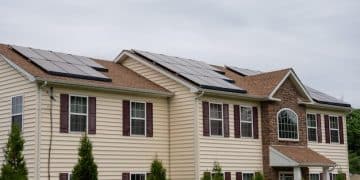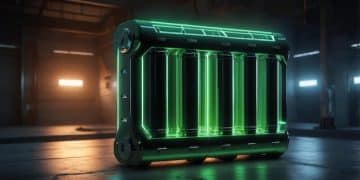How to Size Your Energy Storage System for US Grid Outages

Sizing your energy storage system correctly is crucial for ensuring optimal backup power during US grid outages, involving calculations based on your energy needs, the system’s power and energy capacity, and local grid outage patterns.
Ensuring you have reliable power during a grid outage is crucial, and properly sizing your energy storage system for optimal backup power during US grid outages is the first step. Let’s explore how to determine the right size for your needs.
Understanding Your Energy Needs During Outages
The first step in sizing your energy storage system is understanding how much energy you need to keep essential appliances running during a power outage. This involves assessing which appliances are critical and how much power they consume.
Identifying Essential Appliances
Start by identifying the appliances you can’t live without. These typically include:
- Refrigerator: Keeps food from spoiling.
- Lighting: Provides visibility and safety.
- Medical Devices: Essential for health.
- Communication Devices: Phones, internet routers for emergencies.
Once you have your list, you can move on to understanding your daily energy use.
Calculating Daily Energy Use
To calculate your daily energy use, check the wattage of each appliance. Here’s how:
- Find the wattage label on each appliance.
- Estimate how many hours per day each appliance will run during an outage.
- Multiply wattage by hours used to get watt-hours (Wh).
- Add up the watt-hours for all essential appliances to get your total daily energy consumption.
Knowing this total is vital for selecting an appropriately sized system.

In conclusion, understanding your energy needs involves identifying essential appliances and calculating their total daily energy usage. This assessment forms the basis for sizing an energy storage system that meets your specific backup power requirements.
Determining the Energy Storage System’s Power Capacity
Power capacity is the maximum amount of power an energy storage system can deliver at any given time. It is measured in kilowatts (kW) and must be high enough to run all your essential appliances simultaneously.
Calculating Peak Power Needs
To calculate your peak power needs, determine the maximum wattage required at any one moment. This isn’t just adding up all the wattage of every appliance; it’s figuring out the highest possible combination.
For example, suppose you need to run a refrigerator (200W), a few lights (100W), and a medical device (300W) simultaneously. Your peak power would be 600W, or 0.6kW.
Choosing the Right Inverter Size
The inverter converts DC power from the batteries to AC power for your appliances. It’s important to choose an inverter that can handle your peak power needs.
Select an inverter that has a continuous power rating slightly higher than your calculated peak power. This provides a buffer and prevents overloading.
In summary, determining the right inverter size involves calculating your peak power needs and selecting an inverter with a slightly higher continuous power rating to provide a safety margin.
Assessing the Energy Storage System’s Energy Capacity
Energy capacity refers to the total amount of energy an energy storage system can store. This determines how long you can run your essential appliances during an outage. It’s measured in kilowatt-hours (kWh).
Calculating Total Energy Storage Needed
To calculate the total energy storage needed, multiply your daily energy consumption (in kWh) by the number of days you want to have backup power.
For instance, if you use 5 kWh per day and want 3 days of backup, you need 15 kWh of energy storage.
Considering Depth of Discharge (DoD)
Batteries have a depth of discharge (DoD), which is the percentage of the battery’s capacity that can be used without damaging it. Most batteries have a DoD of 80-90%.
To account for DoD, divide your total energy storage needed by the battery’s DoD percentage. This ensures you don’t over-discharge the batteries.
- Example:
- Need 15 kWh of storage.
- Battery DoD is 80% (0.8).
- Required storage: 15 kWh / 0.8 = 18.75 kWh.
Factoring in Battery Efficiency
It’s also important to factor in the battery’s efficiency, which is the percentage of energy that can be retrieved from the battery compared to the energy put into it.
To account for efficiency, divide the required storage from the previous step by the battery’s efficiency. This will give you the final energy storage capacity needed.
In conclusion, assessing energy capacity involves calculating total energy storage needed, considering depth of discharge, and factoring in battery efficiency to ensure sufficient backup power.

Evaluating Local Grid Outage Patterns
Understanding local grid outage patterns is crucial for accurately sizing your energy storage system. Areas with frequent or extended outages require more robust backup solutions.
Analyzing Frequency and Duration of Outages
Research the typical frequency and duration of power outages in your area. You can find this information from:
- Local utility companies.
- Online outage maps.
- Local news reports.
This data will help you determine how many days of backup power you need.
Considering Seasonal Factors
Power outages are often more common during certain seasons due to storms, extreme temperatures, or increased energy demand. Consider these seasonal factors when sizing your system.
For example, if your area experiences frequent winter storms, plan for longer-duration outages during those months.
Planning for Emergency Situations
During emergencies such as hurricanes, floods, or wildfires, power outages can last for days or even weeks. It’s essential to plan for these extended outages by sizing your energy storage system accordingly.
Integrating Renewable Energy Sources
Combining your energy storage system with renewable energy sources like solar panels can extend your backup power capabilities. Solar panels can recharge your batteries during daylight hours, reducing your reliance on grid power.
In summary, evaluating local grid outage patterns involves analyzing outage frequency and duration, considering seasonal factors, planning for emergency situations, and integrating renewable energy sources to optimize your backup power solution.
Choosing the Right Battery Type
The type of battery you choose will significantly impact the performance, lifespan, and cost of your energy storage system. Understanding the different types of batteries available is crucial for making an informed decision.
Lithium-Ion Batteries
Lithium-ion batteries are commonly used in energy storage systems due to their high energy density, long lifespan, and relatively low maintenance requirements.
They are also lightweight and have a high depth of discharge, making them an excellent choice for backup power applications.
Here are the benefits of Lithium-Ion Batteries:
- High Energy Density: Stores more energy in a smaller space.
- Long Lifespan: Can last for thousands of cycles.
- Low Maintenance: Requires minimal maintenance.
Lead-Acid Batteries
Lead-acid batteries are a more affordable option, but they have a shorter lifespan and lower energy density compared to lithium-ion batteries.
They also require more maintenance and have a lower depth of discharge, which means you can’t use as much of their capacity without damaging them.
- Lower Cost: More affordable upfront.
- Established Technology: Well-understood technology.
Flow Batteries
Flow batteries are a newer technology that offers long lifespans and the ability to scale energy storage capacity independently of power capacity.
They are suitable for large-scale energy storage but may not be the best choice for residential applications due to their size and complexity.
- Long Lifespan: Can last for many years.
- Scalable: Easy to increase storage capacity.
In conclusion, choosing the right battery type involves considering factors such as energy density, lifespan, maintenance requirements, and cost. Lithium-ion batteries are generally preferred for their superior performance, while lead-acid batteries offer a more affordable alternative. Flow batteries are suitable for large-scale applications.
Professional Installation and Maintenance
Proper installation and maintenance are crucial for ensuring the safety, reliability, and longevity of your energy storage system. Hiring qualified professionals and following recommended maintenance practices can help you avoid potential problems and maximize the performance of your system.
Hiring Certified Installers
It’s essential to hire certified installers who have the expertise and experience to install your energy storage system correctly.
They should be familiar with local building codes, electrical regulations, and safety standards.
Here are some of the benefits of hiring certified installers for your energy storage system:
- Ensured Safety: Certified installers follow safety protocols.
- Proper Installation: Ensures the system operates efficiently.
- Warranty Compliance: Some manufacturers require professional installation.
Regular Maintenance Practices
To keep your energy storage system in optimal condition, follow regular maintenance practices. This includes:
- Inspecting batteries for corrosion or damage.
- Keeping the system clean and free of debris.
- Checking wiring connections for tightness and integrity.
Monitoring System Performance
Many energy storage systems come with monitoring capabilities that allow you to track their performance in real-time.
By monitoring metrics such as battery voltage, state of charge, and energy usage, you can detect potential issues early and take corrective action.
In conclusion, professional installation and maintenance are essential for the safe and reliable operation of your energy storage system. Hiring certified installers and following regular maintenance practices can help you avoid potential problems and maximize the performance of your system.
| Key Point | Brief Description |
|---|---|
| 💡 Energy Needs | Assess essential appliances and their daily energy usage. |
| ⚡ Power Capacity | Determine peak power needs and choose the right inverter size. |
| 🔋 Energy Storage | Calculate total energy storage needed, considering DoD and battery efficiency. |
| 🌦️ Outage Patterns | Evaluate local grid outage patterns and plan for emergencies. |
FAQ
▼
Start by listing appliances needed for basic living, such as refrigerators, medical devices, lighting, and communication tools. Consider what you can’t do without during an outage.
▼
DoD is the percentage of battery capacity that can be used safely. Staying within the recommended DoD extends battery life and ensures consistent performance.
▼
Areas with frequent and long outages require larger energy storage systems. Analyze historical data to determine the backup capacity needed for your location.
▼
Lithium-ion batteries have high energy density, long lifespans, and low maintenance. They are lightweight and offer a high depth of discharge, making them ideal for backup power.
▼
Professional installers ensure safety, proper system operation, and compliance with local codes. They also help maintain warranty validity and provide expert guidance.
Conclusion
Sizing your energy storage system correctly ensures you have the backup power needed to navigate grid outages comfortably and safely. By carefully assessing your energy needs, evaluating local outage patterns, and choosing the right components, you can create a reliable and efficient backup power solution.





